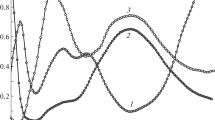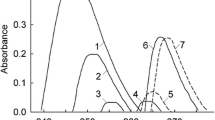Abstract
Electrochemical methods have been used to determine the speciation and stability constants of various aqueous indium complexes. Qualitative behavior is observed using UV–Vis spectroscopy and cyclic voltammetry. Equilibrium constants are determined using differential pulse voltammetry. In a titration where the titrant and sample contain equal concentrations of acid and In3+ ions and equivalent concentrations of ligand and supporting electrolyte anions, respectively, small changes in ligand concentration can be made quickly and accurately while maintaining the overall ionic strength. From the change in the half-wave reduction potential as a function of ligand concentration, the coordination number and the stability constants of sulfate, chloride and nitrate complexes were determined. We also highlight the difficulties finding a supporting electrolyte that does not interact with the In3+ ion. On the one hand, it was not possible to prevent the slow formation of chloride in perchlorate electrolytes containing indium. On the other hand, we show that, at concentrations of nitrate anions commonly used in such experiments, nitrate complexes form. In the light of these new findings, previously published stability constants of indium using nitrate-based supporting electrolytes should be used cautiously.




Similar content being viewed by others
References
Kim, H., Gilmore, C.M., Piqué, A., Horwitz, J.S., Mattoussi, H., Murata, H., Kafafi, Z.H., Chrisey, D.B.: Electrical, optical, and structural properties of indium–tin–oxide thin films for organic light-emitting devices. J. Appl. Phys. 86, 6451–6461 (1999)
George, M.W.: U.S. Geological Survey Minerals Yearbook 2003, 36.1 (2004)
Downs, A.J.: Chemistry of Aluminium, Indium, and Thallium. Springer, Gallium (1993)
Alfantazi, A.M., Moskalyk, R.R.: Processing of indium: a review. Miner. Eng. 16, 687–694 (2003)
Liu, H.Y., Avrutin, V., Izyumskaya, N., Ozgur, U., Morkoc, H.: Transparent conducting oxides for electrode applications in light emitting and absorbing devices. Superlattices Microstruct. 48, 458–484 (2010)
Angerer, G., Erdmann, L., Marscheider-Weidemann, F., Scharp, M., Lüllmann, A., Handke, V., Marwede, M.: Rohstoffe für Zukunftstechnologien. Fraunhofer. IRB Verlag, Stuttgart (2009)
White, S.J.O., Hemond, H.F.: The anthrobiogeochemical cycle of indium: a review of the natural and anthropogenic cycling of indium in the environment. Crit. Rev. Env. Sci. Tech. 42, 155–186 (2012)
Schwarz-Schampera, U., Herzig, P.: Indium: Geology, Mineralogy and Economics. Springer, New York (2002)
Hoffmann, J.E.: Recovering precious metals from electronic scrap. J. Miner. Met. Mater. Soc. 44, 43–48 (1992)
Graeser, S.: Minor elements in sphalerite and galena from Binnatal. Contrib. Mineral. Petrol. 24, 156–162 (1969)
Grafenauer, S., Gorenc, B., Marinkovic, V., Strmole, D., Maksimovic, Z.: Physical properties and the chemical composition of sphalerites from Yugoslavia. Miner. Deposita 4, 275–282 (1969)
Briskey, J.A.: Indium in Zinc–Lead and Other Mineral Deposits—A Reconnaissance Survey of 1118 Indium Analyses Published Before 1985. USGS Survey (2005)
Lee, M.S., Oh, Y.J.: Analysis of ionic equilibria and electrowinning of indium from chloride solutions. Scand. J. Metall. 33, 279–285 (2004)
Han, K., Kondoju, S., Park, K., Kang, H.: Recovery of indium from indium/tin oxides scrap by chemical precipitation. Geosyst. Eng. 5, 93–98 (2002)
Fortes, M.C.B., Martins, A.H., Benedetto, J.S.: Indium adsorption onto ion exchange polymeric resins. Mineral. Eng. 16, 659–663 (2003)
Biedermann, G.: Studies on the hydrolysis of metal ions Part 14. The hydrolysis of the indium(III) ion, In3+. Arkiv Kemi. 9, 277–291 (1956)
Biryuk, E.A., Nazarenko, V.A., Ravitskaya, R.V.: Spectrophotometric determination of the hydrolysis constants of indium ions. Russ. J. Inorg. Chem. 14, 503–506 (1969)
Ferri, D.: Complex formation equilibriums between indium(III) and chloride ions. Acta Chem. Scand. 26, 733–746 (1972)
Rossotti, F.J.C., Rossotti, H.: Studies on the hydrolysis of metal ions Part 15. Partition equilibria in the system 114In/TTA/benzene. Acta. Chem. Scand. 10, 779–792 (1956)
Sundén, N.: On the complex chemistry of the indium ion Part II. The chloride, bromide and sulfate systems. Svensk. Kem. Tidskr. 66, 20–33 (1954)
Hattox, E.M., De Vries, T.: The thermodynamics of aqueous indium sulfate solutions. J. Am. Chem. Soc. 58, 2126–2129 (1936)
Tunaboylu, K., Schwarzenbach, G.: Die löslichkeit von indiumsulfid. Chimia 24, 424–427 (1970)
Licht, S.: Aqueous solubilities, solubility products and standard oxidation–reduction potentials of the metal sulphides. J. Electrochem. Soc. 135, 2971–2975 (1988)
IUPAC SC-Database. IUPAC and Academic Software. Version 5.3 (2003)
Biedermann, G., Li, N., Yu, J.: Studies on the hydrolysis of metal ions Part 34. The hydrolysis of the indium(III) ion in 3 M Cl− medium. Acta Chem. Scand. 15, 555–564 (1961)
Moeller, T.: Contributions to the chemistry of indium. Hydrolysis constants for indium tribromide and triiodide solutions. J. Am. Chem. Soc. 64, 953–954 (1942)
Hepler, L.G., Hugus, Z.Z.: Hydrolysis and halide complexing of indium(III). J. Am. Chem. Soc. 74, 6115–6116 (1952)
Nanda, R.K., Aditya, S.: Studies on ion association equilibria. Spectrophotometric determination of the thermodynamic instability constants of \( {\text{AlSO}}_{4}^{ + } \), \( {\text{GaSO}}_{4}^{ + } \) and \( {\text{InSO}}_{4}^{ + } \). Z. Physik. Chem. 35, 139–145 (1962)
Izatt, R.M.; Eatough, D., Christensen, J.J., Bartholomew, C.H.: Calorimetrically determined log K, ΔH° and ΔS° values for the interaction of sulfate ion with several bi- and ter-valent metal ions. J. Chem. Soc. A 47–53 (1969)
Deichman, E.N., Rodicheva, G.V., Krysina, L.S.: Reaction of indium sulfate with sodium sulfate in aqueous solution. Russ. J. Inorg. Chem. 11, 1199–1201 (1966)
Sundén, N.: On the complex chemistry of the indium ion. Part IV. An investigation of the chloride and sulfate systems by ion exchangers. Svensk Kem. Tidskr. 66, 173–178 (1954)
Carleson, B.G., Irving, H.: The stability constants of the indium halides. J. Chem. Soc. 4390–4399 (1954)
Sundén, N.: On the complex chemistry of the indium ion. Part V. The chloride, bromide and sulfate systems from extraction equilibria. Svensk Kem. Tidskr. 66, 345–350 (1954)
Martell, A.E., Motekaitis, R.J.: Potentiometry revisited: the determination of thermodynamic equilibria in complex multicomponent systems. Coord. Chem. Rev. 100, 323–361 (1990)
Zittel, H.J., Miller, F.J.: A glassy-carbon electrode for voltammetry. Anal. Chem. 37, 200–203 (1965)
Bard, A.J., Faulkner, L.R.: Electrochemical Methods. Wiley, New York (1980)
Ligane, J.: Thermodynamic significance of polarographic half-wave potentials of simple metal ions at the dropping mercury electrode. J. Am. Chem. Soc. 61, 2099–2103 (1939)
Stackelberg, M., Freyhold, H.: Polarographische untersuchungen am komplexen in wässriger lösung. Z. Elektrochem. 46, 120–129 (1940)
DeFord, D., Hume, D.: The determination of consecutive formation constants of complex ions from polarographic data. J. Am. Chem. Soc. 73, 5321–5322 (1951)
Schufle, J., Stubbs, M., Witman, R.: A study of indium(III) chloride complexes by polarographic methods. J. Am. Chem. Soc. 73, 1013–1015 (1951)
Cozzi, D., Vivarelli, S.: Beitrag zur chemie des indiums. Z. Elektrochem. 57, 408–416 (1953)
Kondziela, P., Biernat, J.: Determination of stability constants of indium halogenide complexes by polarography. J. Electroanal. Chem. Interfacial Electrochem. 61, 281–288 (1975)
Heath, G.A., Hefter, G.: The use of differential pulse polarography for the determination of stability constants. J. Electroanal. Chem. 84, 295–302 (1977)
Birke, R.L., Kim, M.-H., Strassfeld, M.: Diagnosis of reversible, quasi-reversible and irreversible electrode processes with differential pulse polarography. Anal. Chem. 53, 852–856 (1981)
Parry, E.P., Osteryoung, R.A.: Evaluation of analytical pulse polarography. Anal. Chem. 37, 1634–1637 (1965)
Dillard, J.W., Hanck, K.W.: Digital simulation of differential pulse polarography. Anal. Chem. 48, 218–222 (1976)
Parkhurst, D.L., Appelo, C.A.J.: Description of input and examples for PHREEQC version 3—a computer program for speciation, batch-reaction, one-dimensional transport, and inverse geochemical calculations. U.S. Geological Survey Techniques and Methods, book 6, Chap. A43 (2013)
Seward, T.M., Henderson, C.M.B., Charnock, J.M.: Indium(III) chloride complexing and solvation in hydrothermal solutions to 350 °C: an EXAFS study. Chem. Geo. 167, 117–127 (2000)
Piercy, R., Hampson, N.: The electrochemistry of indium. J. App. Electrochem. 5, 1–15 (1975)
Bard, A.J., Parsons, R., Jordan, J.: Standard Potentials in Aqueous Solution. Marcel Dekker, New York (1985)
Tuck, D.G.: Critical survey of stability constants of complexes of indium. Pure Appl. Chem. 55, 1477–1528 (1983)
Fridman, Ya.D., Sorochan, R.I., Dolgashova, N.V: Stability of mixed halides of thallium and indium in solutions. Zh. Neorg. Khim. 7, 2127–2133 (1962)
Mikhailova, D.M., Nacheva, R.N., Mikhailova, V.T.: Stability constants of chloride complexes of indium in the presence of alkali metal nitrates as the supporting electrolyte. Radiokhimiya 11, 241–245 (1969)
Schischkova, L.G.: Komplexbildung von indium(III) in wässrigen und wässrigorganischen lösungen verschiedener sulfate. Comptes Rendus Acad. Bulgare Sci. 31, 995–998 (1978)
Ricciu, A., Secco, F., Venturini, M., Garcia, B., Leal, J.M.: Kinetics and equilibria of the interaction of indium(III) with pyrocathecol violet by relaxation spectrometry. J. Phys. Chem. A 104, 7036–7043 (2000)
Tur’yan, Ya.I., Strizhov, N.K.: Polarographic determination of the instability constant of the sulfato-complex of indium(III). Russ. J. Inorg. Chem. 17, 1066–1067 (1972)
Aziz, A., Lyle, S.J.: Partition studies of chemical equilibria in indium(III) fluoride and sulfate systems. J. Inorg. Nucl. Chem. 30, 3223–3229 (1968)
Hasegawa, Y., Shimada, T., Niitsu, M.: Solvent extraction of 3B group metal ions from hydrochloric acid with trioctylphosphine oxide. J. Inorg. Nucl. Chem. 42, 1487–1489 (1980)
Acknowledgements
The authors would like to thank the Dr. Erich-Krüger-Stiftung and the Biohydrometallurgical Center Freiberg for funding and support.
Author information
Authors and Affiliations
Corresponding author
Electronic supplementary material
Below is the link to the electronic supplementary material.
Rights and permissions
About this article
Cite this article
Ashworth, C., Frisch, G. Complexation Equilibria of Indium in Aqueous Chloride, Sulfate and Nitrate Solutions: An Electrochemical Investigation. J Solution Chem 46, 1928–1940 (2017). https://doi.org/10.1007/s10953-017-0675-y
Received:
Accepted:
Published:
Issue Date:
DOI: https://doi.org/10.1007/s10953-017-0675-y




